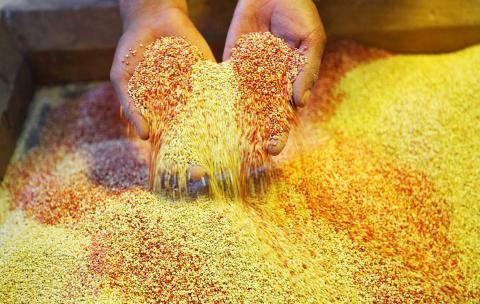Scientists on Wednesday unveiled the near-complete genome of quinoa, a grain cultivated centuries ago by Incas in the Andes that scientists say could help feed a hungry world.
Best known outside its native region to health food fans in North America and Europe, quinoa is highly nutritious, gluten-free, and packed with essential amino acids, fiber, vitamins and minerals, experts say.
It also scores lower than other crops on the glycemic index, a measure of how quickly foods raise blood sugar levels — a major concern for diabetics.

Photo: Aizar Raldes, AFP
The grain thrives at any altitude up to 4,000m above sea level, in conditions that would leave most food plants struggling.
“Quinoa is incredibly resilient, and can grow in poor or salty soils,” said Mark Tester, a professor at King Abdullah University of Science and Technology in Saudi Arabia and leader of the consortium of scholars that decoded the plant’s genome. “It could provide a healthy, nutritious food source for the world using land and water that currently cannot be used.”
And yet, global consumption remains incidental compared to wheat, rice, barley or corn — less than 100,000 tonnes per year compared to hundreds of millions of tonnes for each of the other major grains and cereals.
“One problem with quinoa is that the plant naturally produces bitter-tasting seeds,” Tester explained.
The bitterness — a natural defense against birds and other pests — comes from chemical compounds called saponins.
The process for removing these chemicals is labor-intensive and costly, and requires ample use of water. Another constraint is that quinoa plants tends to have small seed heads and long stalks that can collapse in strong wind or heavy rain.
“Despite its agronomic potential, quinoa is still an underutilized crop, with relatively few active breeding programs,” Tester and three dozen colleagues wrote in the journal Nature.
First grown by humans thousands of years ago in the high plateau around Lake Titicaca in the Andes, quinoa is still barely domesticated, the researchers said. Other major crop plants have been bred for centuries or, more recently, genetically modified to combine optimal traits to boost yield and bolster resistance to pests and climate change.
Now, scientists can delve into the quinoa genome as well.
“Quinoa has great potential to enhance global food security,” Tester said.
The fact that some strains grows well at temperatures up to 38 degrees Celsius, also bodes well for regions hit hardest by global warming.
Tester’s team has already pinpointed genes, including one that controls the production of saponins, that could be altered — through breeding or gene editing — to enhance quality and yields.
“With this new knowledge of quinoa DNA, we can quickly and easily select plants that do not produce bitter substances in the breeding process,” said co-author Robert van Loo, a scientist at Wageningen University and Research Center in the Netherlands.
South American varieties could probably be made sweeter with a single gene change, he added.
Most quinoa is grown in three Andean countries: Peru, Ecuador and Bolivia. The US and Canada account for nearly 70 percent of exports, followed by France, the Netherlands and Germany.
The price of quinoa has nearly tripled in recent years due to increased demand.
If printed, the sequence of letters corresponding to the quinoa genome — comprised of 1.3 billion molecular building blocks — would take up 500,000 pages.

May 11 to May 18 The original Taichung Railway Station was long thought to have been completely razed. Opening on May 15, 1905, the one-story wooden structure soon outgrew its purpose and was replaced in 1917 by a grandiose, Western-style station. During construction on the third-generation station in 2017, workers discovered the service pit for the original station’s locomotive depot. A year later, a small wooden building on site was determined by historians to be the first stationmaster’s office, built around 1908. With these findings, the Taichung Railway Station Cultural Park now boasts that it has

The latest Formosa poll released at the end of last month shows confidence in President William Lai (賴清德) plunged 8.1 percent, while satisfaction with the Lai administration fared worse with a drop of 8.5 percent. Those lacking confidence in Lai jumped by 6 percent and dissatisfaction in his administration spiked up 6.7 percent. Confidence in Lai is still strong at 48.6 percent, compared to 43 percent lacking confidence — but this is his worst result overall since he took office. For the first time, dissatisfaction with his administration surpassed satisfaction, 47.3 to 47.1 percent. Though statistically a tie, for most

In February of this year the Taipei Times reported on the visit of Lienchiang County Commissioner Wang Chung-ming (王忠銘) of the Chinese Nationalist Party (KMT) and a delegation to a lantern festival in Fuzhou’s Mawei District in Fujian Province. “Today, Mawei and Matsu jointly marked the lantern festival,” Wang was quoted as saying, adding that both sides “being of one people,” is a cause for joy. Wang was passing around a common claim of officials of the People’s Republic of China (PRC) and the PRC’s allies and supporters in Taiwan — KMT and the Taiwan People’s Party — and elsewhere: Taiwan and

Six weeks before I embarked on a research mission in Kyoto, I was sitting alone at a bar counter in Melbourne. Next to me, a woman was bragging loudly to a friend: She, too, was heading to Kyoto, I quickly discerned. Except her trip was in four months. And she’d just pulled an all-nighter booking restaurant reservations. As I snooped on the conversation, I broke out in a sweat, panicking because I’d yet to secure a single table. Then I remembered: Eating well in Japan is absolutely not something to lose sleep over. It’s true that the best-known institutions book up faster